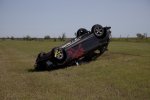I recently had the... misfortune to stumble upon tornado-related sub-Reddits. Now aside from the general awful quality of discourse (dOn'T quEstIOn oFficIAl rAtiNgs) there seems to be a running theme of threads on what the Tri-State tornado may have looked like, or even people posting their own illustrations, some of which are... interesting.
Now most posters here have already come to the conclusion that it probably looked like a large, low based wedge tornado. Some time last year I read the
excellent MWR paper on the Rossville, Kansas tornado family from 1960. This included an interesting passage:
"A number of people have been interviewed who saw the tornado in its formative or early stages; most of them had some difficulty in recognizing it as a tornado. That is, it either did not resemble tornadoes that they had seen previously or it did not correspond to their conception of what a tornado should look like. Most described it as a rather shapeless and poorly defined very dark mass hanging down out of the clouds. Others described it as a black mass resembling a huge cone or ball bulging down from the clouds which, after it carne to earth, seemed to resemble a truncated cone with its apex cut off at the ground and the lower portion obscured by the dust scarf which developed shortly after it hit the ground. Later it seemed to take on the appearance of a connection between the ground and the clouds such as a large pillar or column with its outlines greatly obscured by dust or cloud fragments."
Although perhaps not at the same lifecycle stage, I was strongly reminded of descriptions of the Tri-State tornado, and of course pictures it show a very wide dusty wedge. Particularly pertinent was the fact that people had trouble recognising it as a tornado because it wasn't a taller, narrower funnel. In 1925 not many people would've had photographs at hand, and fewer still a picture of a low, wide one like the 1913 Omaha tornado.
If we look at descriptions of the Tri-state tornado itself, there are many but W.O. Blanchard chose the following:
"The observer, F. M. Hewitt, of Carbondale, occupied a vantage point at DeSota [sic], directly in the path of the storm, which he first noticed when about three fourths of a mile to the southwest. He described the sky above the tornado as a seething boiling mass of clouds whose color changed con- stantly. From the upper portion, there came a roaring noise as of many trains. So definite seemed the source of the noise that it called for his remark to his two companions that the sound all seemed to "come from this upper part." Below this agitated, baggy-shaped mass of cloud, there was a tapering dark cloud mass reaching earthward. Lighter clouds flanked this dark mass upon either side. He estimated the width of the dark pendent portion as one fourth mile where it touched the earth."
Now I can't account for the roar not appearing to come directly from the tornado, but otherwise I think there's nothing exotic going on. From the photogrammetry I have seen, your regular wedge seems to be in the region of 250-300 metres across at the base - that's the condensation funnel - while 400 is getting on the wide side. Considering the width of heavy destruction, Hewitt might even have underestimated. The paper also cites state meteorologist Clarence Root, who advanced the theory of 'an inverted truncated cone' based on descriptions of the Mattoon and Lorain tornadoes, the latter in which the crew of a boat 'saw a very black cloud estimated at one-half mile wide at the water and much wider at the top".
Hewitt's description of a 'baggy shaped mass of cloud' from which the 'tapering mass' (i.e. the tornado itself) emanated makes me think it may actually have had a reasonably prominent wall cloud or mesocyclone base at that point. I have often seen people talk about it probably being rain wrapped etc. hence the odd descriptions and very long tracked rain wrapped tornadoes do happen (e.g Yazoo City). But from most descriptions I have read, it seems to me that most people saw the tornado itself, it just didn't meet their expectations as to what one should look like. After all, there's no particular reason to think that tornadoes then were any different from tornadoes now.

















